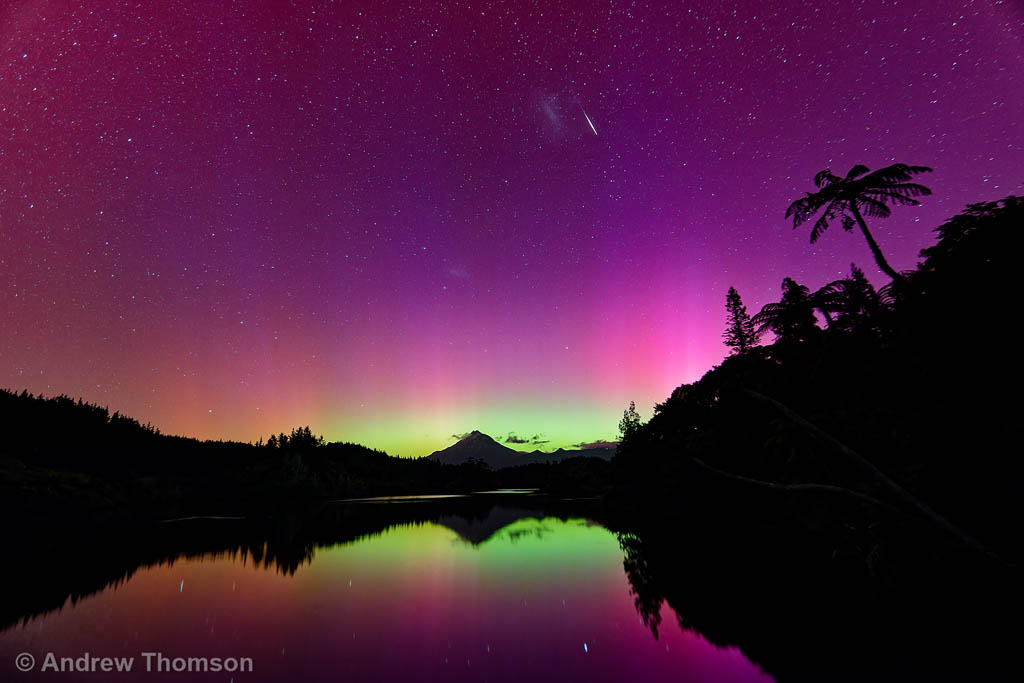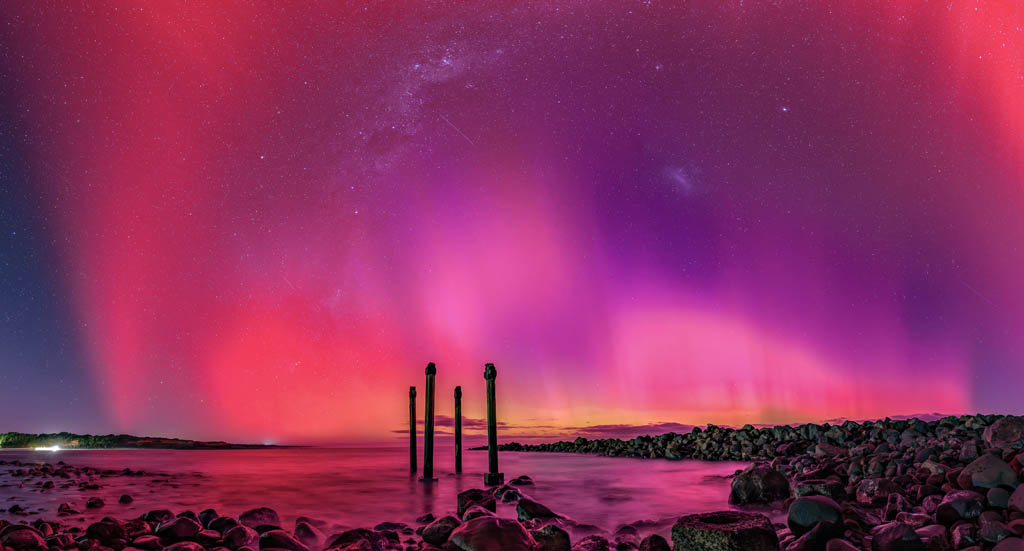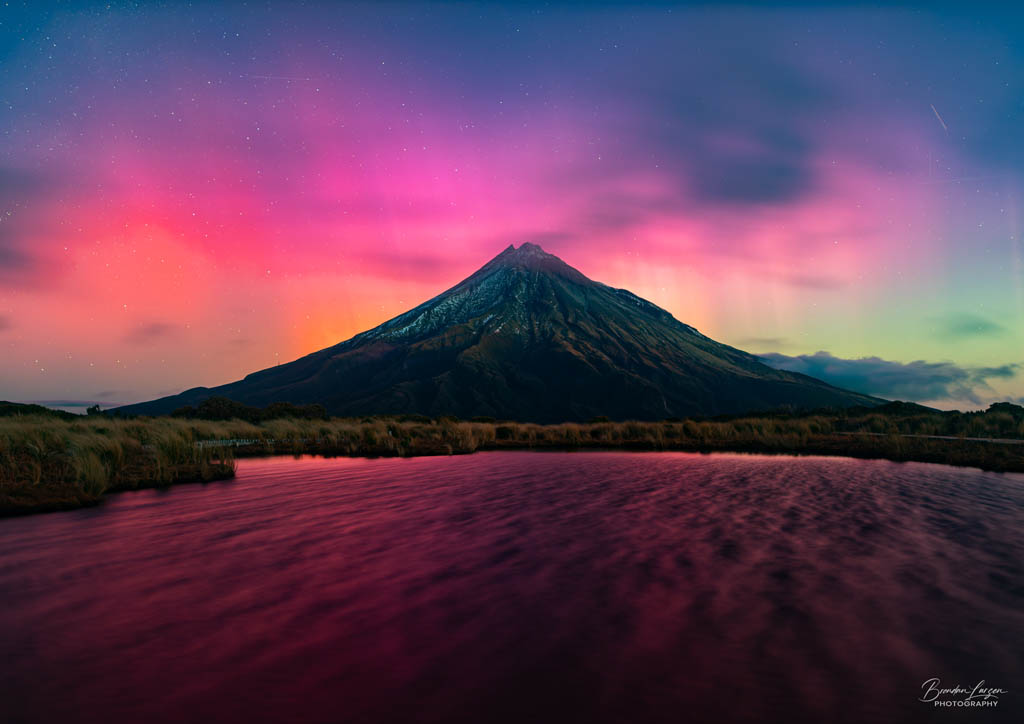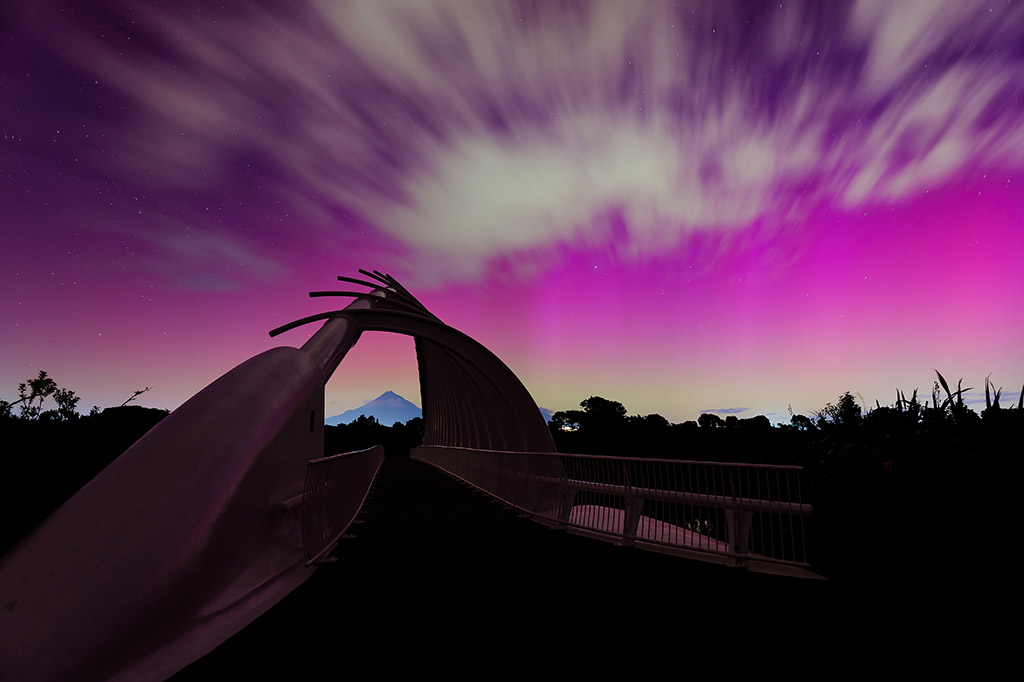For many of us it was a once-in-a-lifetime opportunity to see an aurora.
With the biggest solar storm by far for almost 100 years, a mostly clear night and the smallest sliver of a crescent moon, conditions were perfect to at last see the Southern Lights from Taranaki. It was also sheer luck that the biggest Aurora Australis event Taranaki is likely to see in our current lifetimes, happened to be on a Saturday night — most of us didn’t need to worry about having to get up for work the next day.
The region was swarming with aurora hunters, seeking the perfect spot away from city lights, to look south and watch the spectacular unfold — either with the naked eye or through the viewfinder of a camera (the human eye cannot fully pick up the range, depth and intensity of the colours on offer).
My husband Tony and I headed out from our Fitzroy home at 6.45pm to Te Rewa Rewa Bridge. The car park was packed and I thought the bridge would be thronging with eager “aurorists”. But it seemed most of the people were there for drinks and burn-outs as when Tony and I walked to the bridge there was only one other person there — Russ Dixon the photographer.
As our eyes got accustomed to the darkness, the aurora became visible to the naked eye. I tried looking through the camera of my six-year-old phone but it just offered a black screen. Tony’s new model was much better and the photo below is his. Then Russ offered us a look through his camera. This was an absolutely mind-blowing experience … the intensity of the colours was incredible — I can see why photographers become addicted to chasing aurorae.
Live has gathered together the best aurora shots we could find, that showed different aspects of the event, and asked the photographers for an account of their aurora night.

There was quite a buzz building up about a significant Aurora generating event, caused by a recent solar storm. The last, and only time I had photographed the Aurora Australis was back in Autumn 2022 when visiting another keen photographer in Mosgiel. While we were having dinner, he pulled out his phone and announced that the Kp index was looking good, and we should go out to Blackhead Beach to see if we could get some shots of the Aurora. I was blown away by the colours my camera sensor could see, which I could only see very faintly with the naked eye.
Now, New Plymouth is a whole lot further north than Dunedin, and although I had seen faint images of the Aurora taken by other photographers in Taranaki, I never imagined that I would have the opportunity to capture such colourful images of the Aurora this far north.
During the day of Saturday 11th May, I was frequently checking the Kp Index on the SpaceWeatherLive App on my phone. The Kp Index measures Auroral Activity and goes from zero to nine, and it was consistently reading eight or above. This was an event not to be missed!
The weather was great with clear skies to the south. It seemed the planets were aligning, and I decided that the far end of Lake Mangamahoe would be a great spot, with a clear view of Mt Taranaki. The downside is that the gates are locked about 7:30 pm, so it would require a 25 minute walk to the dam.
There were a few cars driving out of the park as I walked in. No doubt they had been enjoying the view of the sunset on the mountain. But my quest was for a much rarer event. Arriving at the dam at about 6:15 p.m., I could see the light of another photographer. I was a bit surprised there weren’t more of us.
As soon as I set up my tripod and camera and took the first shot, I could see we were in for a real treat! Even in the dusk, we could see the show that was unfolding before us, and it just got better and better. I took my best images between 6:45 p.m. and 7:30 p.m., and then decided to walk back out. Half way back to the car, I had second thoughts and set up the tripod at the first lookout for a few more shots, before heading out. It had certainly been a memorable night to witness this magnificent wonder of creation.

“I knew it was going to be a big event and was even expecting it to start while I was up the mountain on Friday night, although I was still surprised to see it in Taranaki with the naked eye,” says New Plymouth photographer Peter Florence.
“I had planned my location to shoot where I knew there wouldn’t be anyone else shooting. Even though I’m used to walking long distance day on day, I didn’t expect Friday night’s expedition (a 20km hike with all my camera gear in freezing temperatures) to hit me as hard as it did. When it came time to head out on Saturday I knew my planned location wasn’t going to happen and I didn’t have a backup plan. I was even concerned about driving to Opunake I was so physically tired, but came up with three locations to shoot there.
“First stop was the lookout/old wharf, where this image was taken. I headed to the other two Opunake locations only to discover they weren’t accessible.
“Next stop was Stony River and that was clouded in. I met a photographer there that I knew and we discussed going to other places, however in the end I told him I had to get home to bed. At that stage the Aurora had lost its strength and was pretty much just a pink glow in the sky … the curtains had faded away.
In hindsight I regret not staying for the second wave which had the green clouds in it, as that was what I was keen to capture.
“In the end we make our choices depending on how we feel. I’m still happy with the images that I got and of course the highlight was actually see the colours and curtains with the naked eye.
“It is challenging planning astrophotography around working full-time, our cloudy mountain and moon phases, but it’s still enjoyable.”

The decision was made to head up to Pouakai Tarns to try to capture the aurora from there.
It was a bit of risky move because it’s a 2.5 to 3 hour hike up to the Tarns and if it ended up being cloudy up the mountain it would be difficult to relocate to a different location with better weather.
When we first arrived, the mountain was almost totally clouded over and it was very cold and very windy, but we set up anyway in the hopes that it would clear up and there would be aurora.
Proper darkness wasn’t starting until around 7pm, but by 6:15pm we were in action, and we could already see auroral colour with the naked eye.
By around 6:30pm we could see massive auroral beams with our eyes. The aurora was so strong and big that it stretched from East to West and beyond overhead. I even got one shot facing north that had aurora in it! This was the first time for me to see naked eye visible aurora, and it was right here in Taranaki. It was an incredible experience that I’ll never forget.
The Lanky Photographer has put together a time lapse of his aurora experience, from the 1500 images he took on the night. You can view it at: https://www.facebook.com/TheLankyPhotographer/videos/782215993890357
